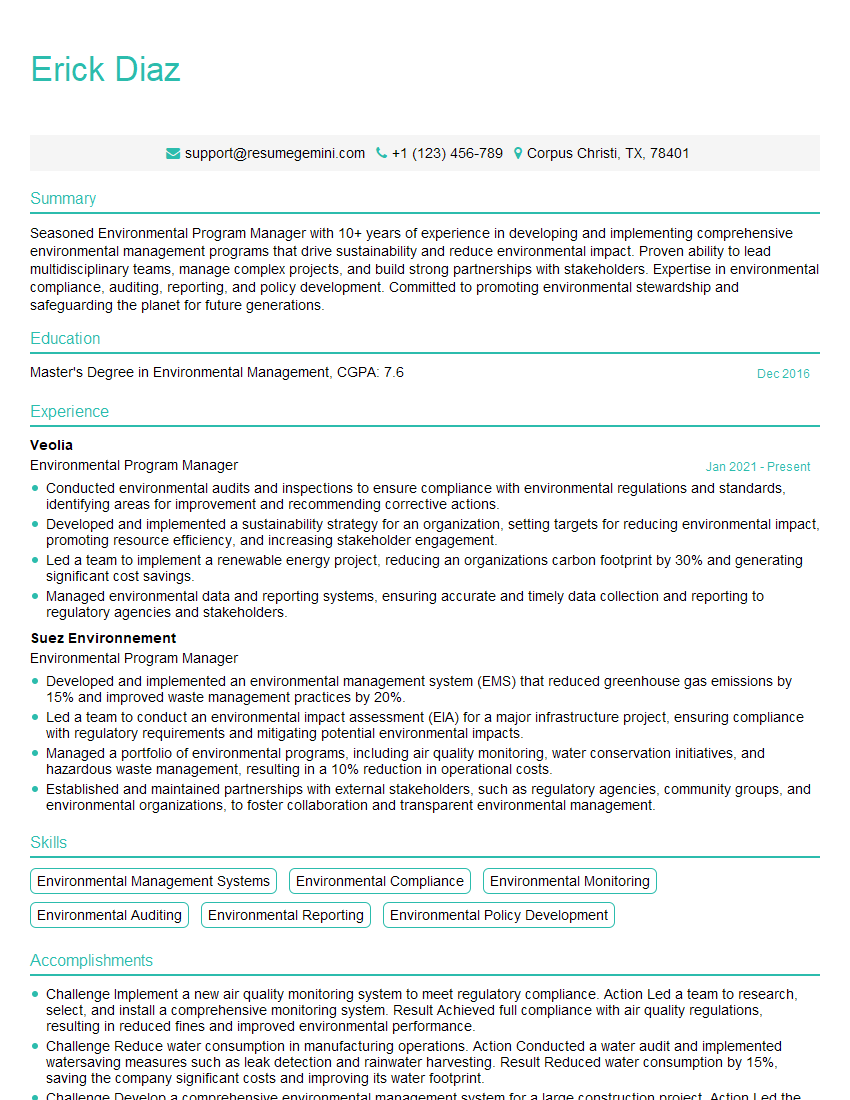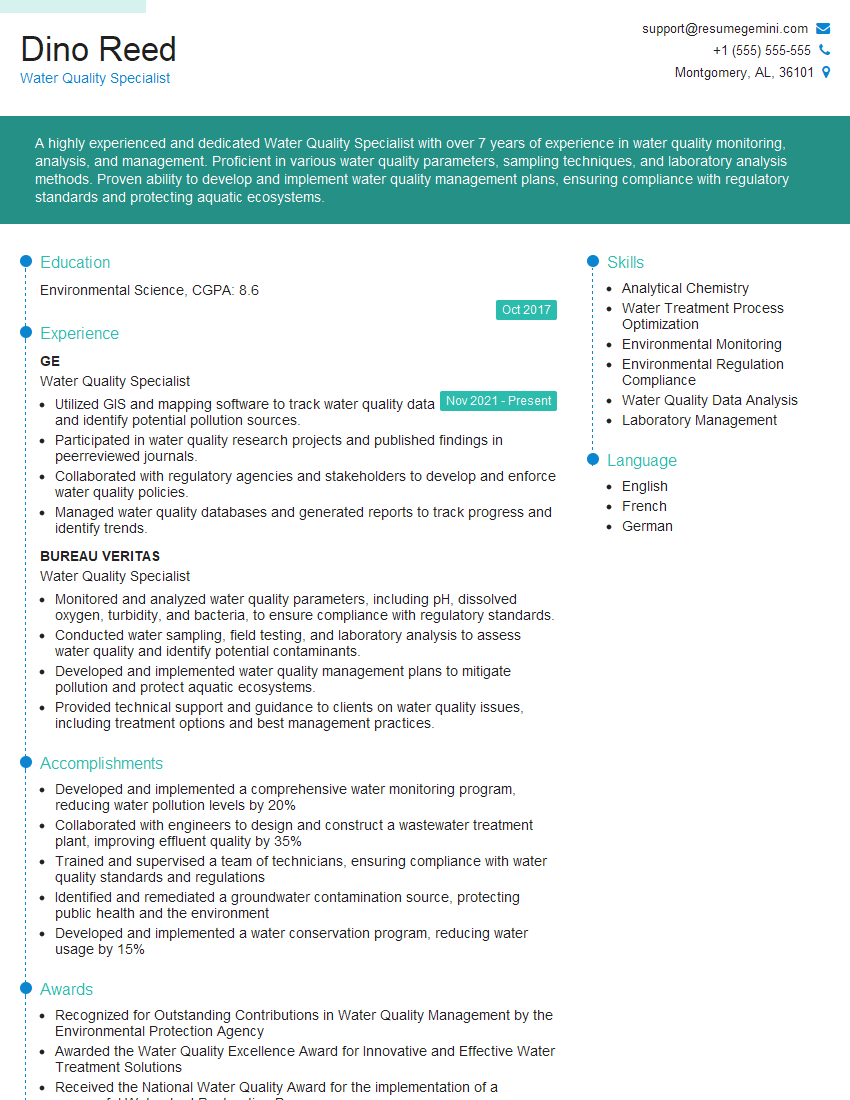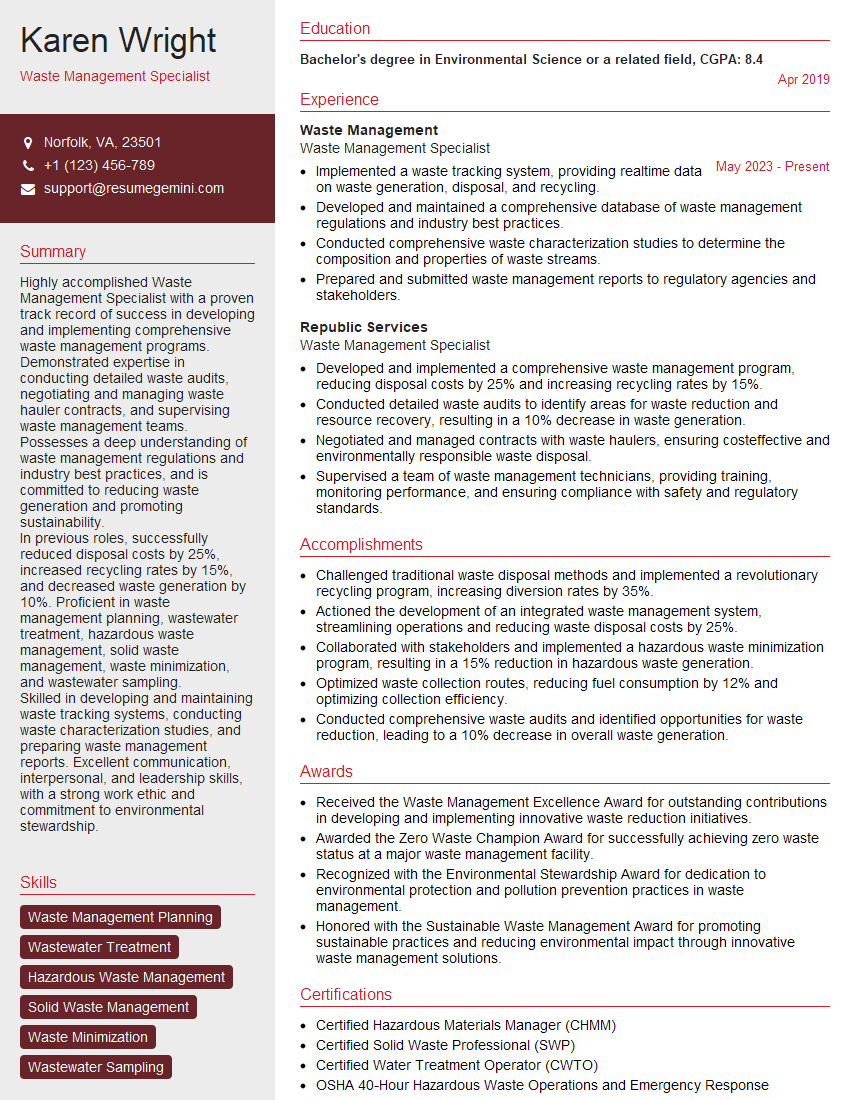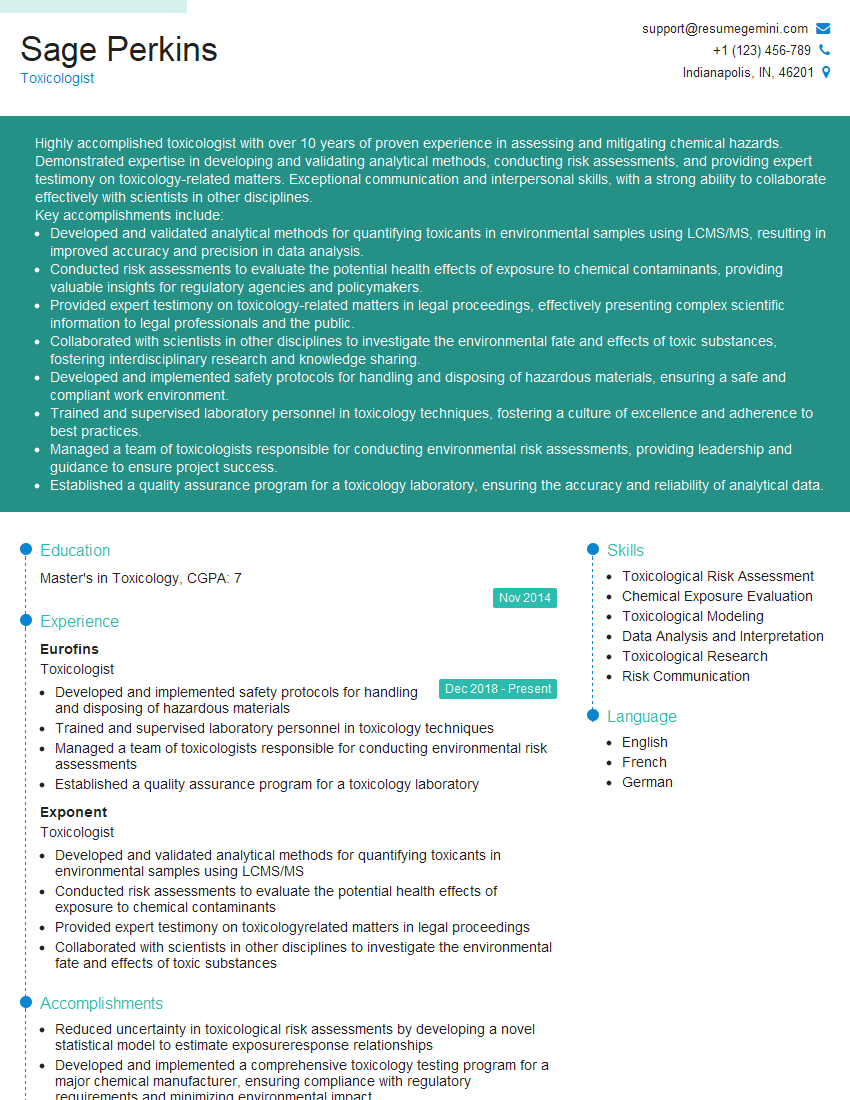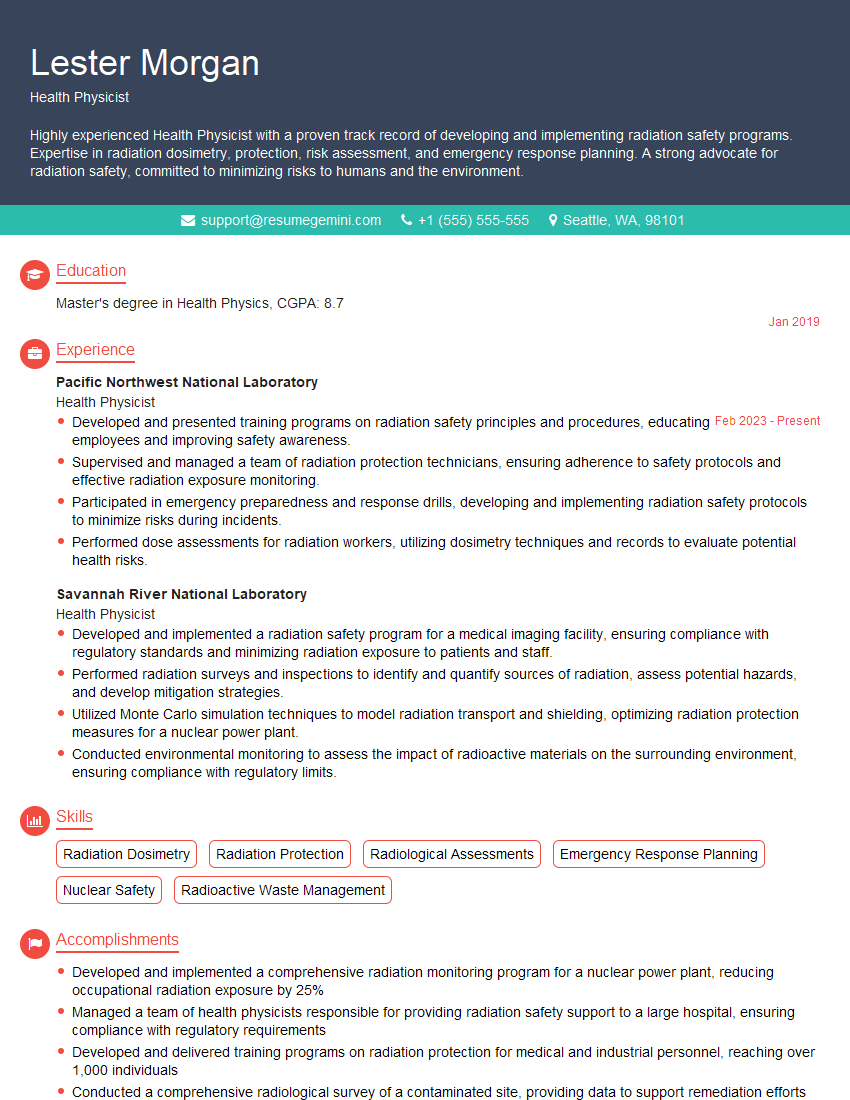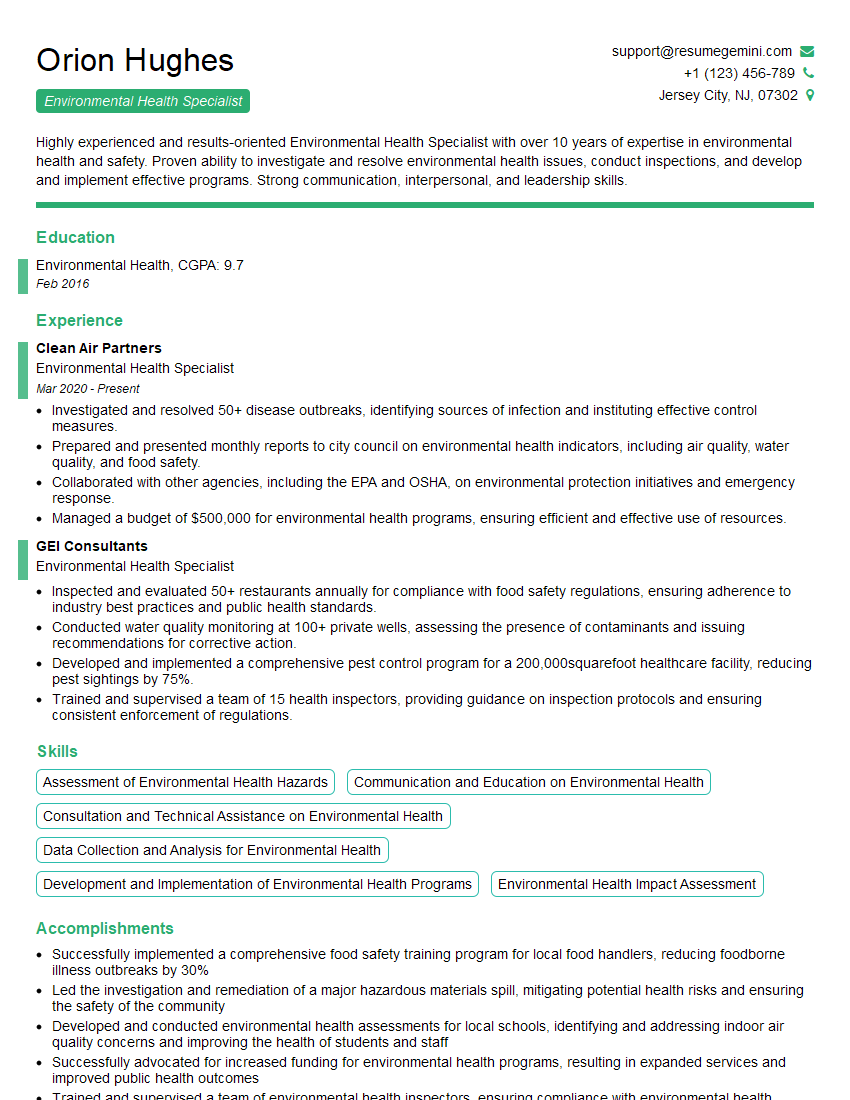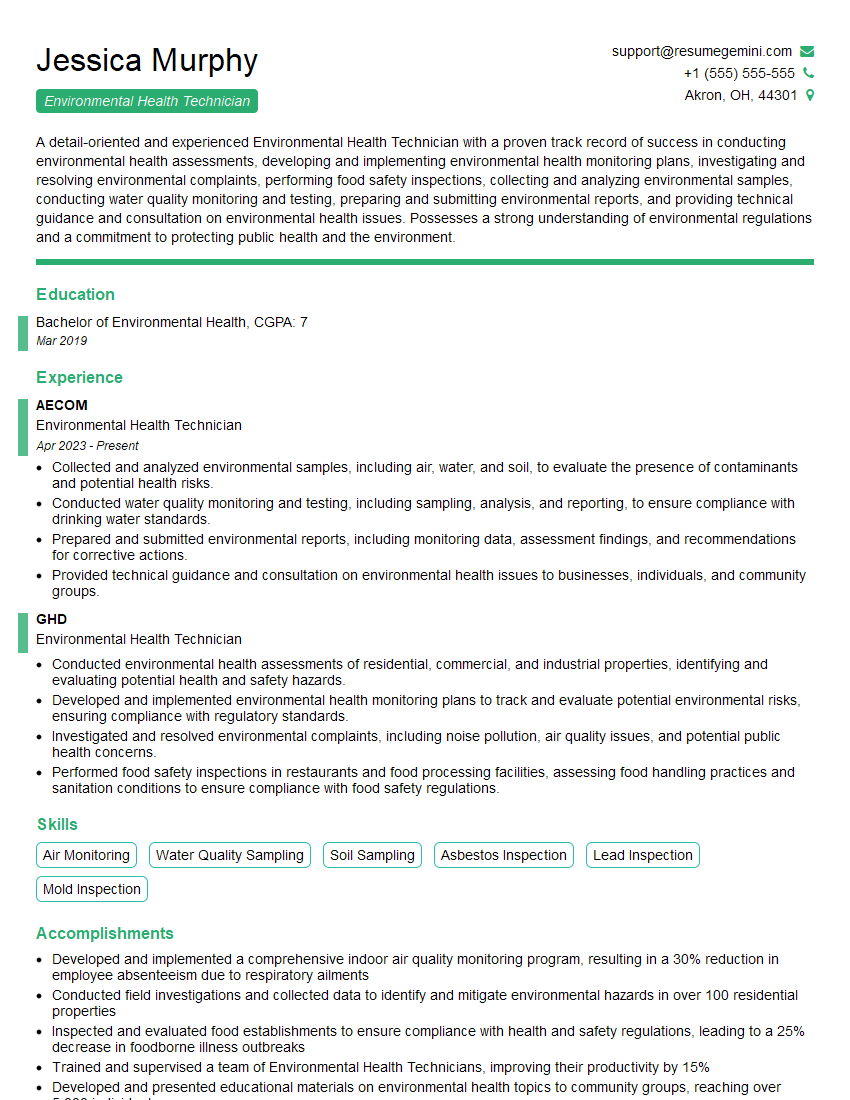The right preparation can turn an interview into an opportunity to showcase your expertise. This guide to Environmental Health Protection interview questions is your ultimate resource, providing key insights and tips to help you ace your responses and stand out as a top candidate.
Questions Asked in Environmental Health Protection Interview
Q 1. Describe your experience in assessing environmental health risks.
Assessing environmental health risks involves a systematic process of identifying, characterizing, and quantifying potential hazards to human health and the environment. My experience encompasses a wide range of risk assessments, from evaluating the impact of industrial emissions on local air quality to assessing the potential contamination of groundwater sources from agricultural runoff. This includes using various quantitative and qualitative methods, such as statistical modeling, exposure assessment, and dose-response analyses to estimate the probability and severity of adverse health effects. For example, in one project, I used Geographic Information Systems (GIS) to map contaminant plumes from a leaking underground storage tank and determined the potential exposure pathways to nearby residents. This allowed us to prioritize remediation efforts and communicate potential risks effectively to the community.
I also have extensive experience working with various stakeholders, including regulatory agencies, industry representatives, and community members, to ensure the comprehensiveness and transparency of my risk assessments. Effective communication and collaboration are vital to ensure the findings are readily understood and used for decision-making.
Q 2. Explain your understanding of environmental regulations (e.g., Clean Air Act, Clean Water Act).
My understanding of environmental regulations is comprehensive and covers many key acts and associated guidelines. The Clean Air Act (CAA), for example, sets national ambient air quality standards (NAAQS) to protect public health and welfare from harmful air pollutants. I am familiar with the various permitting processes, emission standards, and enforcement mechanisms under the CAA, including the permitting of stationary sources like power plants and the regulation of mobile sources like vehicles. Similarly, the Clean Water Act (CWA) aims to restore and maintain the chemical, physical, and biological integrity of the nation’s waters. My knowledge extends to the CWA’s National Pollutant Discharge Elimination System (NPDES) permit program, which regulates point source discharges of pollutants into waters. I also understand the complexities of addressing non-point source pollution from diffuse sources like agricultural runoff. Beyond these, I have a working knowledge of the Resource Conservation and Recovery Act (RCRA) regarding hazardous waste management, the Comprehensive Environmental Response, Compensation, and Liability Act (CERCLA) – also known as Superfund – for cleanup of hazardous waste sites, and numerous state-specific regulations that often provide more stringent standards.
Q 3. How do you conduct a risk assessment for a potential environmental hazard?
Conducting a risk assessment for a potential environmental hazard follows a structured four-step process: Hazard Identification, Hazard Characterization, Exposure Assessment, and Risk Characterization.
- Hazard Identification: Identifying the potential hazards present. This might involve a site visit, reviewing historical data, or analyzing samples to determine if hazardous substances are present.
- Hazard Characterization: Determining the toxic properties of the identified hazards, including their potential to cause adverse health effects or environmental damage. This involves evaluating toxicity data from various sources.
- Exposure Assessment: Estimating the amount and duration of contact between the exposed population (humans or other organisms) and the identified hazards. This requires considering the pathways of exposure (e.g., inhalation, ingestion, dermal contact) and the potential for exposure to vary among different groups.
- Risk Characterization: Combining information from the previous steps to quantify the overall risk. This involves estimating the probability and magnitude of adverse health effects or environmental damage resulting from exposure to the identified hazard. Often, risk is expressed as a probability (e.g., 1 in 10,000 chance of developing cancer).
Think of it like baking a cake. Hazard identification is like identifying the ingredients, hazard characterization is understanding the properties of each ingredient, exposure assessment is how much of each ingredient is used, and risk characterization is the final product – the overall evaluation of the success (or failure) of the baking process, similar to the level of risk.
Q 4. What are your methods for sampling and analyzing environmental contaminants?
My methods for sampling and analyzing environmental contaminants are tailored to the specific contaminant and the environmental matrix (soil, water, air). Sampling protocols are rigorously followed to ensure representative samples are collected. This often involves using specialized equipment and adhering to strict quality assurance/quality control (QA/QC) procedures to maintain data accuracy and reliability. For example, when sampling groundwater, I would use dedicated bailers or peristaltic pumps to avoid contamination, while air sampling might involve specialized filters and pumps.
Analysis techniques are equally varied and are selected based on the suspected contaminants and their concentrations. Common methods include gas chromatography-mass spectrometry (GC-MS) for volatile organic compounds (VOCs), high-performance liquid chromatography (HPLC) for pesticides, and inductively coupled plasma-mass spectrometry (ICP-MS) for heavy metals. Data analysis involves interpreting the results, considering QA/QC flags, and reporting the findings in a clear and concise manner.
Q 5. How familiar are you with environmental monitoring techniques and equipment?
I am highly familiar with a wide range of environmental monitoring techniques and equipment. This includes both field and laboratory techniques. Field equipment encompasses everything from portable gas detectors for immediate hazard assessment to advanced monitoring systems for long-term data collection. Laboratory equipment includes sophisticated analytical instrumentation such as those mentioned previously (GC-MS, HPLC, ICP-MS) as well as specialized equipment for sample preparation and analysis. I am also adept at using GIS software to map and visualize environmental data, allowing for spatial analysis and effective communication of monitoring results. My knowledge of quality control procedures is crucial to ensure the reliability and validity of the environmental monitoring data collected.
For example, I’ve used continuous air monitoring stations to track air quality around industrial facilities, and deployed passive samplers to monitor long-term pollutant exposure. Understanding the strengths and limitations of different techniques is critical in selecting the most appropriate methods for each monitoring project.
Q 6. Describe your experience in investigating environmental complaints.
Investigating environmental complaints involves a systematic approach starting with a thorough review of the complaint itself, gathering all relevant information such as the nature of the complaint, location, time of occurrence, and potential sources. Next, I would conduct a site visit to assess the situation firsthand. This might involve collecting environmental samples, documenting observations, and interviewing affected parties or witnesses.
Data analysis and interpretation are key. I would review the collected data, correlate it with other information, and determine potential causal relationships. For instance, if a complaint alleges foul odors emanating from a nearby factory, I would analyze air samples for VOCs and compare them to emission standards. The investigation culminates in the preparation of a comprehensive report detailing the findings, conclusions, and recommendations for resolving the issue. This process requires strong communication skills, as interacting with individuals from varied backgrounds and potentially resolving conflict are often part of the process.
Q 7. Explain your approach to enforcing environmental regulations.
Enforcing environmental regulations requires a balanced approach that combines education, cooperation, and, when necessary, punitive measures. My approach prioritizes education and voluntary compliance whenever possible. This involves working with regulated entities to ensure they understand their obligations under the relevant regulations and providing technical assistance to help them achieve compliance.
When voluntary compliance is not achieved, more forceful measures might be necessary. This could range from issuing warnings and notices of violation to imposing fines or taking legal action. The specific enforcement strategy depends on the severity of the violation, the history of compliance of the regulated entity, and the potential environmental and public health impacts. Documenting all actions taken and maintaining detailed records is critical for transparency and accountability. The aim is always to achieve environmental protection while fostering a collaborative relationship with regulated communities to ensure long-term environmental stewardship.
Q 8. How do you communicate complex environmental issues to non-technical audiences?
Communicating complex environmental issues to non-technical audiences requires translating scientific jargon into plain language and using relatable analogies. Instead of using terms like ‘anthropogenic greenhouse gas emissions,’ I’d explain it as ‘the pollution we humans create that warms the planet.’ I rely heavily on visuals like charts, graphs, and infographics to illustrate data and trends. Storytelling is also crucial – sharing real-world examples of the impacts of pollution on communities or ecosystems makes the issue more tangible and emotionally resonant. For instance, instead of simply stating the decline in bee populations, I’d share a story about a local farmer whose crops have suffered due to the decrease in bee pollination. I also ensure that my communication is tailored to the specific audience; a presentation for schoolchildren will differ significantly from one for policymakers.
For example, explaining the concept of biodiversity loss, I would avoid using technical terms like ‘alpha diversity’ or ‘beta diversity’ and instead focus on the importance of a variety of plants and animals for a healthy ecosystem, comparing it to a well-balanced diet for humans. Using real-world examples, such as the impact of deforestation on local wildlife or the role of pollinators in food production, makes the issue more understandable and engaging.
Q 9. Describe your experience with environmental impact assessments.
My experience with Environmental Impact Assessments (EIAs) spans over ten years, encompassing various projects from large-scale infrastructure developments to smaller-scale industrial projects. I’ve been involved in all phases of the EIA process, from scoping studies and baseline data collection to impact prediction, mitigation planning, and the preparation of EIA reports. I’m proficient in using various modeling software and tools to predict potential environmental impacts, such as air and water quality modeling. In one project involving a proposed highway expansion, I led the team in assessing the potential impacts on wetlands and developed mitigation strategies that included creating new wetlands elsewhere and minimizing habitat fragmentation. This required close collaboration with ecologists, hydrologists, and other specialists. The final EIA report, which I contributed significantly to, was instrumental in securing necessary approvals while ensuring environmentally sound practices were incorporated into the project’s design.
My approach to EIAs emphasizes a proactive and holistic perspective, incorporating stakeholder engagement throughout the process. This ensures that concerns and perspectives from the affected communities are addressed and integrated into the mitigation plans.
Q 10. How do you prioritize environmental health issues in a resource-constrained environment?
Prioritizing environmental health issues with limited resources demands a strategic approach. I utilize a risk assessment framework, combining the likelihood and severity of potential adverse health effects. For example, a high likelihood of water contamination with serious health risks would rank higher than a low likelihood of soil contamination with mild health consequences, even if the latter requires more complex remediation. I consider factors like the population at risk, the availability of mitigation measures, and the long-term costs associated with inaction. A cost-benefit analysis is often employed, considering both the financial and health implications. This might involve focusing resources on addressing immediate threats to public health before tackling longer-term environmental concerns. Prioritization also involves collaboration with stakeholders to develop shared goals and identify cost-effective interventions. For instance, in a community with limited resources, focusing on improving sanitation infrastructure might be more effective and cost-efficient than implementing extensive air quality monitoring programs.
Q 11. Explain your understanding of different waste management strategies.
Waste management strategies are diverse, ranging from the simple to the highly sophisticated. They are broadly categorized into waste reduction, reuse, recycling, recovery, and disposal. Waste reduction involves minimizing waste generation at the source – think designing products for durability and repairability. Reuse involves extending the life of products before disposal. Recycling converts waste materials into new products. Recovery involves extracting valuable resources or energy from waste, such as composting organic waste or generating biogas from landfill gas. Disposal, typically landfill, is the last resort. Effective waste management requires an integrated approach using a waste hierarchy. This prioritizes waste reduction and reuse over recycling and disposal. For instance, a comprehensive strategy might involve implementing a robust composting program to reduce organic waste going to landfills, alongside community-based recycling initiatives.
Q 12. How do you ensure compliance with environmental regulations in a workplace?
Ensuring compliance with environmental regulations in a workplace is a multi-faceted process requiring a proactive and preventative approach. This starts with identifying all applicable regulations and standards, which vary by location and industry. We conduct regular audits to assess our compliance against these standards. These audits cover aspects such as waste disposal procedures, emissions monitoring, and chemical handling protocols. Employee training programs are crucial to ensure everyone understands their role in environmental protection. We maintain detailed records of our environmental performance – including permits, licenses, and monitoring data. This data is used to track progress, identify areas needing improvement, and demonstrate compliance to regulatory authorities. Furthermore, proactive measures such as implementing preventative maintenance programs for equipment to minimize emissions or spills are critical. When non-compliance occurs, a thorough investigation is conducted to identify root causes, implement corrective actions, and prevent future recurrence. In cases of significant violations, we immediately engage with regulatory agencies to ensure transparent and effective remediation.
Q 13. Describe your experience in developing and implementing environmental health programs.
I have extensive experience developing and implementing environmental health programs, ranging from workplace safety programs to community-based initiatives. One notable example involves developing a comprehensive air quality management program for a large industrial complex. This included conducting baseline air quality assessments, implementing emission control technologies, and establishing a robust monitoring system. Employee training on safe handling of hazardous materials was also a key component. The program resulted in a significant reduction in harmful emissions, leading to improved air quality in the surrounding community. Another project involved developing and implementing a community-based waste management program. This entailed community outreach, educational campaigns, and the establishment of a recycling program alongside infrastructure improvements. The program resulted in increased community engagement and significant improvements in waste management practices. My approach to program development emphasizes a community-centered participatory approach, ensuring that programs are tailored to local needs and priorities.
Q 14. How do you manage environmental data and information?
Effective environmental data management is crucial for informed decision-making and regulatory compliance. I utilize Geographic Information Systems (GIS) and environmental data management software to store, analyze, and visualize environmental data. This includes air and water quality data, waste generation data, and ecological data. Data is organized using standardized protocols to ensure consistency and facilitate analysis. Data quality control measures are essential, ensuring accuracy and reliability. Regular data backups are implemented to prevent loss of information. Data security measures are also in place to protect sensitive information. Depending on the nature of the data and project requirements, appropriate statistical analysis techniques are used to extract meaningful insights and support decision-making. For example, trend analysis of air quality data might highlight the effectiveness of pollution control measures, while spatial analysis could identify areas with high pollution levels requiring targeted intervention.
Q 15. What is your experience with environmental auditing techniques?
Environmental auditing involves systematically evaluating an organization’s environmental performance against established standards and regulations. It’s like a comprehensive health check for a company’s environmental footprint. My experience encompasses conducting both compliance audits, verifying adherence to legal requirements, and management system audits, assessing the effectiveness of environmental management systems like ISO 14001.
For example, I’ve conducted audits for manufacturing plants, assessing their waste management practices, emissions controls, and resource consumption. This involved reviewing documentation, conducting site inspections, sampling environmental media (air, water, soil), and interviewing personnel. I’ve used various auditing techniques, including checklists, sampling plans, and data analysis, to identify non-conformances and areas for improvement. I also have experience in developing audit reports that provide clear, concise findings and recommendations for corrective action.
In one specific case, an audit of a chemical processing facility revealed a significant deficiency in their hazardous waste storage procedures, posing a potential environmental and health risk. My report detailed the non-conformances, including photos and data, leading to the company implementing corrective actions and preventing a potential environmental disaster. My findings helped them to improve their waste management practices and strengthen their overall environmental performance.
Career Expert Tips:
- Ace those interviews! Prepare effectively by reviewing the Top 50 Most Common Interview Questions on ResumeGemini.
- Navigate your job search with confidence! Explore a wide range of Career Tips on ResumeGemini. Learn about common challenges and recommendations to overcome them.
- Craft the perfect resume! Master the Art of Resume Writing with ResumeGemini’s guide. Showcase your unique qualifications and achievements effectively.
- Don’t miss out on holiday savings! Build your dream resume with ResumeGemini’s ATS optimized templates.
Q 16. Describe your experience with health risk assessment methodologies.
Health risk assessment is a systematic process of identifying hazards, characterizing potential exposure, and estimating the associated risks to human health. It’s like predicting the likelihood and severity of someone getting sick from an environmental exposure. My experience involves applying various methodologies, including quantitative and qualitative risk assessment, depending on the data availability and the complexity of the scenario. I’m proficient in using exposure assessment models and risk characterization frameworks to estimate the probability and magnitude of adverse health effects.
For instance, I’ve conducted health risk assessments for communities near industrial facilities, evaluating potential exposure to air pollutants like particulate matter or heavy metals. This involved gathering data on pollutant concentrations, population demographics, exposure pathways (e.g., inhalation, ingestion), and health effects data from epidemiological studies. I utilized established models, such as the EPA’s risk assessment guidance, to quantify the potential risks and communicate the findings to stakeholders in a clear and understandable manner.
One particularly challenging project involved assessing the health risks associated with contaminated groundwater. This required a multi-disciplinary approach, coordinating with hydrogeologists, chemists, and epidemiologists to develop a comprehensive understanding of the contaminant fate and transport, exposure pathways, and potential health impacts. The resulting risk assessment guided remediation efforts and helped to protect public health.
Q 17. How do you handle disagreements with stakeholders on environmental issues?
Disagreements among stakeholders on environmental issues are common, as different parties often have conflicting interests. My approach is based on fostering open communication, transparency, and mutual respect. I believe in active listening, seeking to understand each stakeholder’s perspective and concerns before presenting my own.
I often facilitate collaborative discussions, using tools like mediation and consensus-building techniques, to find common ground and develop solutions that are acceptable to all parties. This includes presenting objective data and scientific evidence to support my recommendations, while acknowledging the validity of other perspectives. It’s important to remember that compromise is often necessary in environmental management, finding a balance between environmental protection and economic development.
For example, in a project involving a proposed landfill near a residential area, I facilitated discussions between the developer, residents, and regulatory agencies. By presenting data on potential environmental impacts, I helped to build trust and create a collaborative environment. This resulted in the developer agreeing to modify their proposal, incorporating stronger environmental safeguards and mitigating potential impacts on the local community. The use of transparent and unbiased scientific data allowed me to facilitate a positive outcome for all involved.
Q 18. What is your approach to emergency response in environmental health crises?
Emergency response in environmental health crises requires a rapid, coordinated, and effective response to minimize health and environmental impacts. My approach is based on a well-defined emergency response plan that includes pre-defined roles and responsibilities, communication protocols, and established procedures for incident management. This plan is akin to a fire drill; everyone knows their roles and responsibilities so that in a crisis, actions are timely and efficient.
My experience encompasses developing and implementing emergency response plans for various scenarios, including chemical spills, hazardous material releases, and natural disasters. This involves assessing potential hazards, identifying vulnerable populations, establishing communication channels, and coordinating response activities with relevant agencies (e.g., fire department, emergency medical services, environmental protection agencies). It also involves post-incident investigation and evaluation, identifying lessons learned, and improving the emergency response plan for future incidents.
In one instance, I was involved in the response to a chemical spill at an industrial facility. My role included coordinating the on-site assessment, identifying the extent of contamination, and recommending appropriate cleanup actions. This involved working with emergency responders, environmental consultants, and regulatory agencies to ensure a safe and effective cleanup operation. Following the incident, we updated the emergency response plan to account for lessons learned from the spill, enhancing preparedness for future incidents.
Q 19. How do you stay updated on the latest environmental health regulations and best practices?
Staying updated on environmental health regulations and best practices is crucial for maintaining professional competence and providing effective environmental health services. My approach is multifaceted and includes regularly reviewing publications from authoritative bodies such as the EPA, WHO, and relevant professional organizations.
I actively participate in professional development activities, attending conferences, workshops, and training courses to stay abreast of the latest advancements in environmental health science and technology. I also subscribe to relevant journals and newsletters, ensuring I receive regular updates on emerging environmental issues and regulatory changes. Online resources and professional networks play an important role too, allowing for continuous learning and peer-to-peer knowledge exchange.
Furthermore, I maintain a network of contacts with other professionals in the field, enabling me to exchange information and share experiences. For example, I recently attended a conference on climate change adaptation and its impact on public health, which provided me with valuable insights into the latest research and policy developments.
Q 20. Explain your understanding of the relationship between environmental health and public health.
Environmental health and public health are intrinsically linked; one cannot exist without the other. Environmental health focuses on the physical, chemical, and biological factors in the environment that may affect human health and well-being. Public health, on the other hand, is concerned with the overall health of the population and the prevention of disease and injury. Think of it this way: environmental health is a critical component of public health; it’s the foundation upon which we build a healthy population.
Many public health issues, such as respiratory illnesses, waterborne diseases, and certain types of cancer, are directly linked to environmental factors. Protecting the environment, therefore, is essential for protecting public health. For example, ensuring access to clean water and air, managing waste properly, and preventing pollution are all crucial environmental health interventions with significant positive impacts on public health outcomes.
My work directly bridges these two fields. For example, in assessing the health risks of air pollution, I’m considering not just the environmental concentrations of pollutants but also the consequent health effects on the population. The outcomes inform public health interventions like implementing air quality standards or issuing public health advisories during pollution events.
Q 21. How do you use technology to improve environmental health practices?
Technology plays an increasingly important role in improving environmental health practices, enhancing data collection, analysis, and dissemination. I utilize various technologies, including Geographic Information Systems (GIS) for mapping environmental hazards and assessing risk, remote sensing for monitoring environmental conditions, and air and water quality monitoring sensors for real-time data acquisition.
For instance, I utilize GIS software to map the distribution of environmental hazards, such as contaminated sites or areas with poor air quality, allowing for targeted interventions and resource allocation. I also use data analytics and statistical modeling to identify trends, predict risks, and evaluate the effectiveness of interventions. Remote sensing provides a valuable tool for monitoring large areas, such as forests or water bodies, detecting changes in land use or water quality and providing early warnings of potential environmental issues. Using predictive modeling software to forecast the impact of climate change on public health allows for the development of proactive interventions.
Furthermore, I utilize various software applications for data management and report generation, streamlining my workflow and improving the efficiency and accuracy of my work. The use of these technologies allows for better data-driven decision-making and enhanced environmental health outcomes.
Q 22. Describe a time you had to make a difficult decision regarding environmental health.
One of the most difficult decisions I faced involved a proposed industrial development near a sensitive wetland ecosystem. The project promised significant economic benefits to the community, creating jobs and boosting local revenue. However, my environmental impact assessment revealed a high risk of water contamination and habitat destruction. The decision wasn’t simply about choosing economic prosperity over environmental protection; it was about finding a balance that minimized negative impacts while maximizing the positive ones.
My approach involved several steps: first, a thorough risk assessment, quantifying the potential environmental damage against the projected economic gains. Second, I engaged in extensive stakeholder consultations—meeting with developers, community leaders, environmental groups, and local residents to understand their concerns and perspectives. Third, I explored mitigation strategies, suggesting modifications to the project design to reduce its environmental footprint, such as implementing advanced wastewater treatment systems and creating buffer zones around the wetland. Finally, I presented all the information, including the modified proposal with mitigation measures, to the decision-making body, advocating for a solution that prioritized environmental sustainability while acknowledging the economic needs of the community. The decision was ultimately to proceed with the modified plan, representing a compromise that aimed to balance economic and environmental interests. This experience underscored the importance of transparency, collaboration, and a multi-faceted approach to environmental decision-making.
Q 23. What are the key indicators you use to measure the effectiveness of an environmental health program?
Measuring the effectiveness of an environmental health program requires a multi-pronged approach using both quantitative and qualitative indicators. We need to track changes in environmental conditions and their impact on human health.
- Environmental Indicators: These reflect the success of the program in improving environmental quality. Examples include reductions in air and water pollution levels (measured through air quality index scores and water quality testing), decreased incidence of vector-borne diseases (e.g., malaria or Zika), improved waste management rates (e.g., increased recycling percentages, decreased landfill volume), and levels of soil contamination.
- Health Indicators: These show whether the program’s interventions have improved public health. Examples include reductions in respiratory illnesses, incidence of waterborne diseases, and rates of lead poisoning in children. We also look at self-reported health outcomes through surveys to gauge community perception.
- Process Indicators: These measure the program’s efficiency and effectiveness. Examples include the number of individuals participating in outreach programs, compliance rates with environmental regulations, resource utilization, and successful implementation of environmental policies.
Ideally, these indicators should be tracked over time to establish a baseline, monitor progress, and evaluate the program’s long-term impact. A robust data analysis is crucial to interpreting the results accurately and making data-driven decisions for program improvement.
Q 24. How familiar are you with Geographic Information Systems (GIS) in environmental applications?
I’m highly proficient in using Geographic Information Systems (GIS) for environmental applications. GIS provides powerful tools for visualizing, analyzing, and managing geographically referenced data, which is essential in environmental health.
In my work, I’ve utilized GIS for various tasks, including:
- Mapping pollution sources and assessing their impact: We can overlay pollution data with population density maps to identify vulnerable communities most at risk.
- Modeling disease outbreaks: GIS helps visualize disease clusters and predict potential spread, guiding public health interventions.
- Monitoring environmental changes over time: Using time-series data, we can track deforestation, habitat loss, or changes in water quality.
- Planning environmental remediation projects: GIS allows for efficient planning and resource allocation for clean-up efforts, identifying the most effective remediation strategies.
My experience with GIS software includes ArcGIS and QGIS, and I’m familiar with various spatial analysis techniques, such as buffer analysis, overlay analysis, and spatial interpolation. I believe GIS is an indispensable tool for effective environmental health management, enabling data-driven decision-making and informed policy development.
Q 25. Explain your understanding of the precautionary principle in environmental health.
The precautionary principle is a cornerstone of environmental health protection. It states that when an activity raises threats of harm to human health or the environment, precautionary measures should be taken even if some cause-and-effect relationships are not fully established scientifically. In simpler terms, it’s better to be safe than sorry, especially when dealing with potentially irreversible environmental damage.
The principle emphasizes proactive risk management, rather than reacting only after harm has occurred. This is crucial because scientific research is often time-consuming and may not provide definitive answers quickly enough to prevent environmental damage. For example, if a new chemical is introduced into the environment, even without conclusive evidence of its toxicity, the precautionary principle would suggest implementing restrictions or limitations on its use until more information becomes available. This approach helps avoid potentially catastrophic consequences to both human health and the environment. The principle is often applied to cases involving genetically modified organisms, new technologies, and emerging pollutants where the long-term effects may not be fully understood yet.
Q 26. Describe your experience with community engagement in environmental health initiatives.
Community engagement is fundamental to successful environmental health initiatives. Meaningful engagement builds trust, ensures program relevance, and improves compliance. My experience includes various participatory methods:
- Public forums and town hall meetings: These provide platforms for open dialogue, allowing communities to express their concerns and priorities.
- Focus groups and surveys: These help gather detailed information about community perceptions, health concerns, and environmental priorities.
- Participatory mapping: This involves working with community members to identify environmental hazards and map out areas needing attention. This empowers communities to contribute their knowledge to problem solving.
- Collaborations with local NGOs and community-based organizations: This establishes strong partnerships and ensures that programs are culturally sensitive and responsive to community needs.
A recent project involved working with a low-income community near an industrial site to address air pollution concerns. Through community engagement activities, we identified the specific pollutants causing problems, assessed their health impacts, and worked collaboratively to develop solutions. This participatory approach not only improved the effectiveness of our interventions but also empowered the community to become active agents in protecting their environmental health.
Q 27. What are some emerging challenges in Environmental Health protection?
Environmental health protection faces several emerging challenges in the 21st century:
- Climate change: The increasing frequency and intensity of extreme weather events (heat waves, floods, droughts) pose significant risks to human health and the environment. This necessitates new strategies for adaptation and mitigation.
- Antimicrobial resistance: The overuse of antibiotics contributes to the rise of drug-resistant bacteria, threatening our ability to treat infections. This is linked to environmental pollution via pharmaceutical waste.
- Microplastics: The ubiquitous presence of microplastics in the environment poses unknown risks to both human and environmental health, requiring further research and management strategies.
- Chemical pollution: The constant release of new chemicals into the environment poses challenges for monitoring, assessment, and risk management, demanding advanced analytical tools and assessment strategies.
- Population growth and urbanization: Rapid urbanization and population growth exacerbate environmental health risks, necessitating innovative urban planning and resource management practices.
Addressing these challenges requires a holistic approach, including interdisciplinary research, robust monitoring systems, proactive regulations, and international collaboration.
Q 28. How do you balance economic considerations with environmental protection measures?
Balancing economic considerations with environmental protection is a crucial aspect of environmental health management. It’s not a simple trade-off, but rather a process of finding sustainable solutions that integrate both economic development and environmental sustainability.
Several strategies can be used to achieve this balance:
- Cost-benefit analysis: Assessing the economic costs of environmental damage against the costs of implementing protection measures helps to prioritize interventions.
- Internalizing environmental costs: Incorporating the environmental costs (e.g., pollution cleanup, health impacts) into the price of goods and services encourages environmentally responsible practices.
- Investing in green technologies and sustainable infrastructure: Investing in renewable energy, energy-efficient technologies, and sustainable waste management systems can both improve environmental health and stimulate economic growth.
- Promoting green jobs and a circular economy: Creating new jobs in environmentally friendly sectors and promoting a circular economy (reducing waste and reusing materials) benefits both the environment and the economy.
- Incentivizing environmentally responsible behavior: Providing tax incentives, subsidies, and other incentives for businesses and individuals to adopt environmentally friendly practices promotes sustainable development.
It’s about finding innovative solutions that consider the long-term economic and environmental consequences, fostering a sustainable future where economic prosperity and environmental health go hand-in-hand.
Key Topics to Learn for Environmental Health Protection Interview
- Environmental Risk Assessment: Understanding methodologies for identifying, analyzing, and managing environmental hazards. This includes exposure pathways, dose-response relationships, and risk characterization.
- Water Quality Management: Practical application of water quality standards, treatment technologies, and monitoring strategies to ensure safe and potable water supplies. Consider discussing specific contaminants and remediation techniques.
- Air Pollution Control: Knowledge of air quality regulations, emission sources, control technologies (e.g., scrubbers, filters), and air monitoring techniques. Prepare to discuss strategies for mitigating air pollution and improving air quality.
- Waste Management and Recycling: Understanding waste generation, characterization, treatment, disposal, and recycling methods. Be prepared to discuss sustainable waste management practices and their environmental impact.
- Occupational Health and Safety: Knowledge of workplace hazards related to environmental exposures (e.g., asbestos, lead, pesticides) and implementation of safety protocols and regulations to protect workers’ health.
- Environmental Remediation: Understanding the principles and techniques for cleaning up contaminated sites (e.g., soil, groundwater). Discuss different remediation technologies and their effectiveness.
- Environmental Legislation and Policy: Familiarity with key environmental laws and regulations at local, national, and international levels. Consider how these regulations are implemented and enforced.
- Environmental Monitoring and Data Analysis: Understanding data collection methods, analytical techniques, and interpretation of environmental data to assess the effectiveness of environmental programs and identify emerging issues.
- Sustainability and Climate Change: Knowledge of sustainable practices and their role in mitigating climate change impacts. Discuss strategies for reducing greenhouse gas emissions and promoting environmental sustainability.
- Communication and Stakeholder Engagement: Ability to effectively communicate complex environmental issues to diverse audiences, including the public, policymakers, and other stakeholders. This includes presenting data, explaining technical concepts clearly and concisely, and building consensus.
Next Steps
Mastering Environmental Health Protection opens doors to a rewarding career with significant impact. Demand for skilled professionals in this field is consistently high, offering excellent career growth potential and the chance to contribute to a healthier planet. To maximize your job prospects, crafting a strong, ATS-friendly resume is crucial. ResumeGemini is a trusted resource to help you build a professional and impactful resume that highlights your skills and experience effectively. Examples of resumes tailored to Environmental Health Protection are available to help guide you.
Explore more articles
Users Rating of Our Blogs
Share Your Experience
We value your feedback! Please rate our content and share your thoughts (optional).
What Readers Say About Our Blog
This was kind of a unique content I found around the specialized skills. Very helpful questions and good detailed answers.
Very Helpful blog, thank you Interviewgemini team.

